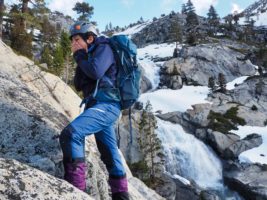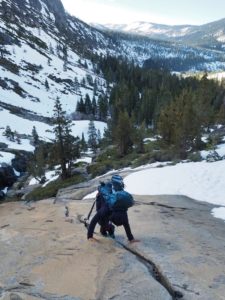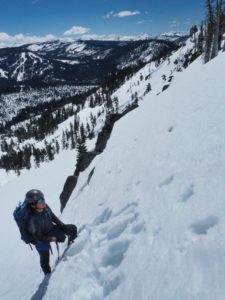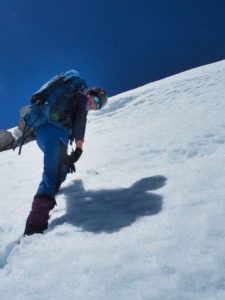That was my son’s conclusion after today’s climb. At 9000 feet his head was aching with that uncomfortable combination of altitude, sun exposure, fatigue, and dehydration that mountaineers are so familiar with. Pyramid would have to wait for us another time. Less than a 1000 feet to reach the summit. So close, but impossibly far at the same time.
This Winter I bought Nacho his first pair of mountaineering boots and crampons. He has been practicing self belay and self arrest over the last couple of years, but it was time to take his climbing to the next level. One of our goals is to climb Shasta. This does not only requires competency using crampons and ice axe, but also fitness and endurance to ascend 7000 feet in a couple of days.
With 4000 ft of elevation gain, climbing Pyramid in a day would be a good preparation for that challenge, so last Sunday we woke up at 3:30, loaded up the car and drove to the trailhead to start climbing before sunrise.
The first obstacle was the Pyramid Creek headwall. It’s an easy third class scramble that we have climbed several times during the summer, but climbing it in early Spring, with mountaineering boots, and during the first hours of the day is a different story.
Hands get cold at the touch of the rock. The melting snow makes the rock wet and slippery. Sometimes it even blocks the route entirely; one of the gullies that we usually climb had become a small waterfall so we had to find an alternate route that was more exposed.
To my delight, Nacho seemed extremely comfortable climbing in boots. He was able to move fast, intuitively, and with confidence. I’m super happy with the Trango Tower boots I purchased (he’s using the women’s version, because I couldn’t get the men’s in his size).
The upper part of the headwall was completely covered in snow. It was still cold and the snow was frozen, so we switched to crampons, but by the time we topped off the headwall the sun was already up and the snow was starting to get soft, so we had to take them off and put snow shoes on.
When we arrived to the south east ridge it became clear it was gonna pose an interesting challenge. The entire ridge was lined with a giant cornice. It appeared to have broken off at several points and the entire slope showed signs of wet avalanche, in particular over the East Face couloir; the route we were planning to take.
The gentler slopes north of it didn’t look much better either, so we decided to skirt the ridge to the south until the end of the cornice, probe the snow there, and go back down if the conditions didn’t seem safe. I may have over estimated the risk of avalanche, but the tragic dead of David Lama in an avalanche a few days ago still resonated in my mind so I decided to act conservatively.
We approached the ridge following what seemed a tree lined ledge and at the end of it we went straight up. The snow was solid and stable enough, but steeper than I had expected; at some point it was nearly 70 degrees. Nacho had never climbed snow so steep, so naturally I was a bit nervous, but he was able to follow me without any problem. I even let him break trail for a while.
When he was near the top he stopped and said he could not get a good purchase with his ice axe. I caught up to him to see what was going on and suddenly slipped down a hidden moat that was covered by snow. I fell all the way down to my chest and couldn’t touch the bottom with my feet! I held onto my ice axe, kicked to the sides of the moat and pulled myself up. I wonder how he would have reacted in my situation! but luckily the snow bridge was strong enough to hold his weight.
The cornice over the moat was hard and almost vertical, but it was only a few feet tall. I kicked some good steps and built a ladder with our ice axes and we went over it without much trouble.
Getting over that last obstacle was exhilarating. We were both ecstatic we had made it this far. However, as we continued over the ridge the excitement faded and his energy dwindled. We had to take numerous breaks and it became clear that Nacho was having signs of altitude sickness. At 9000 feet we took a long break, lied on our backpacks, and replenished our energy, but the symptoms didn’t fade and it was getting late (we had been climbing for more than 8 hours), so we decided to call it a day head back down.
Lessons learned: It’s clear that Nacho needs more time for altitude adaptation. If I were to do this again I would travel the night before and sleep at the trailhead. This would also have allowed us to start climbing earlier. Moving in the cold while the snow is hard is faster and safer than over soft snow, and we could have avoided the use of snow shoes. I still have to help Nacho put on his crampons and tighten his snowshoes. These transitions take a long time. He needs to get more practice so that we can do this quicker and in parallel.



